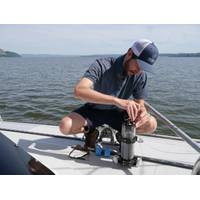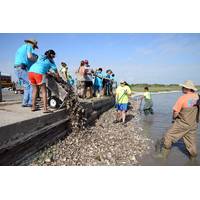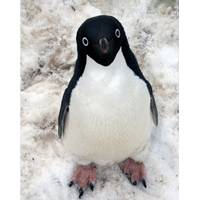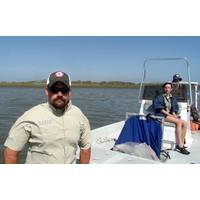
SMTP Helps to Power Future Ocean Tech
all over the globe. Dan Watson, founder of SafetyNet, and his team developed a light emitting device that helps fishermen and women identify the right fish. This device has the ability to lower bycatch by 90% and increase revenue by 25%—saving more fish, helping people, and protecting a vital food source.Dan of SafetyNet Technologies discusses his plans while getting input from the local fishing community in Indonesia. Credit: Mark Schrope.In order to offer experimental flexibility their devices span different geometries and sizes and can be fitted to any kind of fish capture equipment. Most of

Deaths of North Atlantic Right Whales Puzzle Scientists
the whales are so large, Wimmer and her colleagues need a backhoe to get inside the animals to perform necropsies. The whales, designated a species at risk, have been sighted in the Gulf of St. Lawrence in higher-than-normal numbers this summer, Davies said, possibly because their zooplankton food source is scarcer in other habitats such as the Gulf of Maine and the Bay of Fundy. Canada's Department of Fisheries and Oceans closed some snow crab fisheries early in response to the deaths, and has asked ships in the high-traffic Gulf of St. Lawrence to voluntarily keep their speed to 10

Sonar Systems Help Search Teams, Scientists and Salvors
buried in the soft bottom. Chong Zhao is an assistant professor at Dalian Ocean University’s Key Laboratory of Mari Culture and Stock Enhancement. His research includes work on how changes in the ocean environment affect marine life in the East China Sea. This area is an important food source for the Chinese people. Two of the tools Zhao and his team use to gather data are JW Fishers SSS-100K/600K side scan sonar and the SeaLion-2 ROV. The side scan provides high resolution images of the sea floor allowing scientists to clearly see the varying bottom conditions in different areas.
Tropical Coral reefs lose their Zooplankton through Ocean Acidification
of hard coral grow, offering the zooplankton little shelter. In a study published on 19 September 2016 at the online portal of the journal Nature Climate Change, the researchers report that the impact on the food web of the coral reefs is far-reaching, since these micro-organisms are an important food source for fish and coral. The volcanic carbon dioxide sources off the coast of Papua New Guinea are a unique natural laboratory. "Here, we can already observe under natural conditions how the reefs may change when the world's oceans absorb more and more carbon dioxide from the atmosphere and
Oil-hungry Bacteria Could Clean Up Next Big Oil Spill
from oil-contaminated waters of the Gulf of Mexico shortly after the spill occurred, samples that contained key species of bacteria that fed on the oil. Experiments with the samples revealed that certain bacteria had thrived on the oil that gushed into the Gulf, devouring the oil as a preferred food source. In a paper published in Nature Microbiology Dr Gutierrez and his colleagues from the University of Texas and University of North Carolina at Chapel Hill reveal the genetic pathways these bacteria use to consume the oil, what conditions they thrive in, what oil hydrocarbons they can eat, and

Fate of Past Oyster Reef Projects Unknown
will send billions to the five Gulf States for restoration projects, with more than $160 million earmarked for oyster restoration projects. “Oysters accomplish a lot within the environment, and provide important ecosystem services,” Blomberg said. “They’re an important food source and support vital fisheries.” In addition, as filter feeders, oysters remove excess phytoplankton and nutrients to help clean the water column. That helps prevent harmful algal blooms and a form of water pollution known as eutrophication, which can cause hypoxia (areas of low-to-no oxygen
Newborn Killer Whale Presumed Dead in Washington
and intelligent marine mammals that communicate using whistles and pulsed calls and maintain group cohesion or "pods" through their lifetime, according to the National Oceanic and Atmospheric Administration (NOAA). Threats to the population include pollution and overfishing of their major food source, chinook salmon, near the San Juan Islands in the Salish Sea. The whales also have been hurt by vessel noise and military exercises using sonar, artillery and bombs that can upset their underwater communications and foraging behavior, according to the Center for Whale Research. (Reporting

Climate Change Winners and Losers
species because of its impact on penguin food supplies. The underside of sea ice serves as a nursery for young krill, shrimp-like crustaceans that feed on algae growing beneath the ice. Decreased sea ice in the Antarctic Peninsula over the past 50 years has brought a reduction in krill, an important food source for penguins. As a result, Adélie and chinstrap penguin populations are dropping at a precipitous rate in the Antarctic Peninsula, according to several recent studies. “There may be more breeding habitat available now, but there may not be enough food available to sustain those

Research Shows Channels' Effects on Marine Life
and researchers will continue to take samples and compare to pre-opening samples. Hall said he’ll be paying particular interest to red drum, a recreationally important fish, and a big draw for fishermen. Hall will also be watching for increases in the population of blue crabs, the main food source of another big tourist draw, wintering whooping cranes that bring in birders for boat trips to islands in the area. Hall’s research has received funding from Texas Parks and Wildlife Department and Coastal Conservation Association.



 February 2024
February 2024





